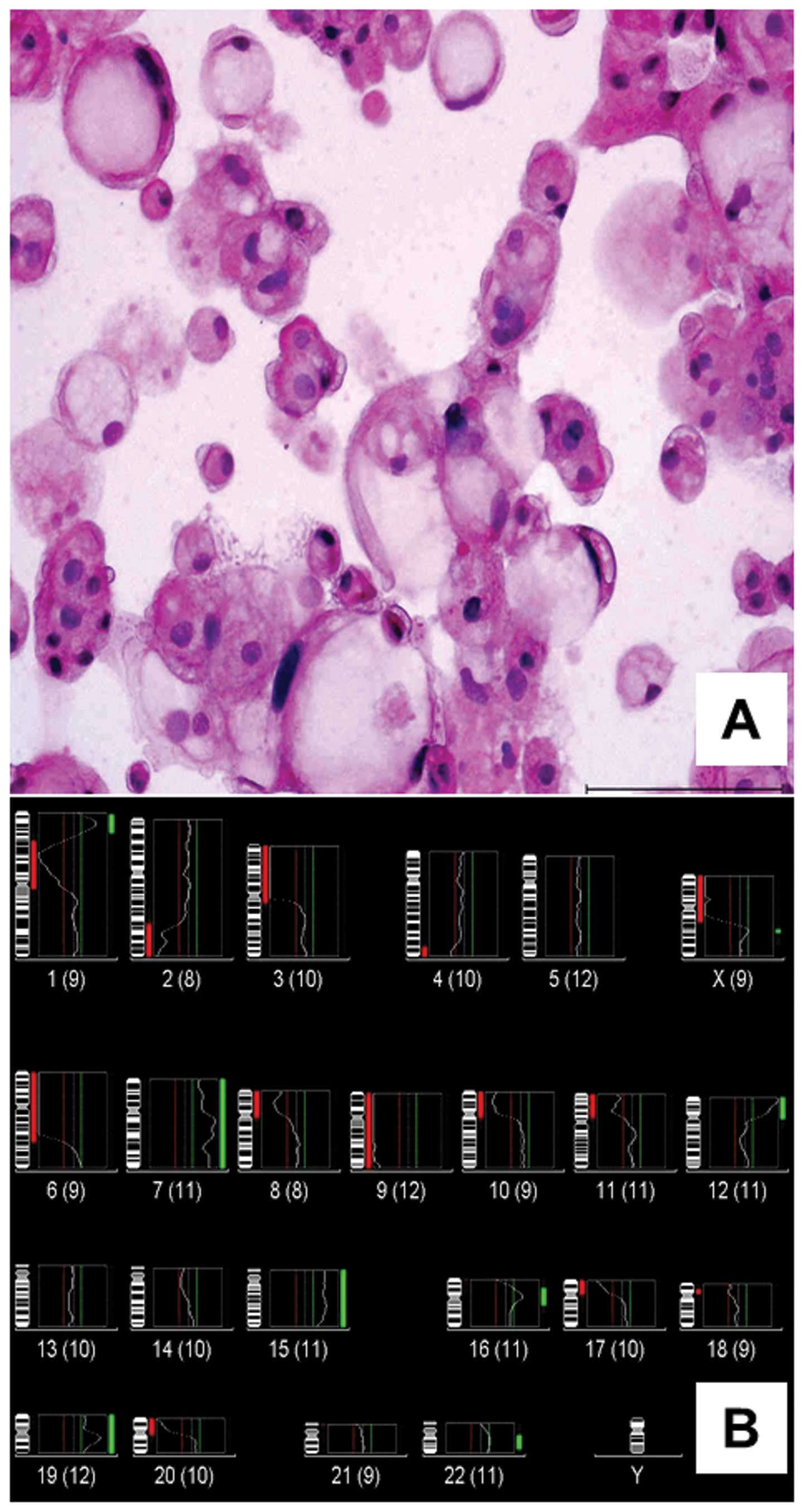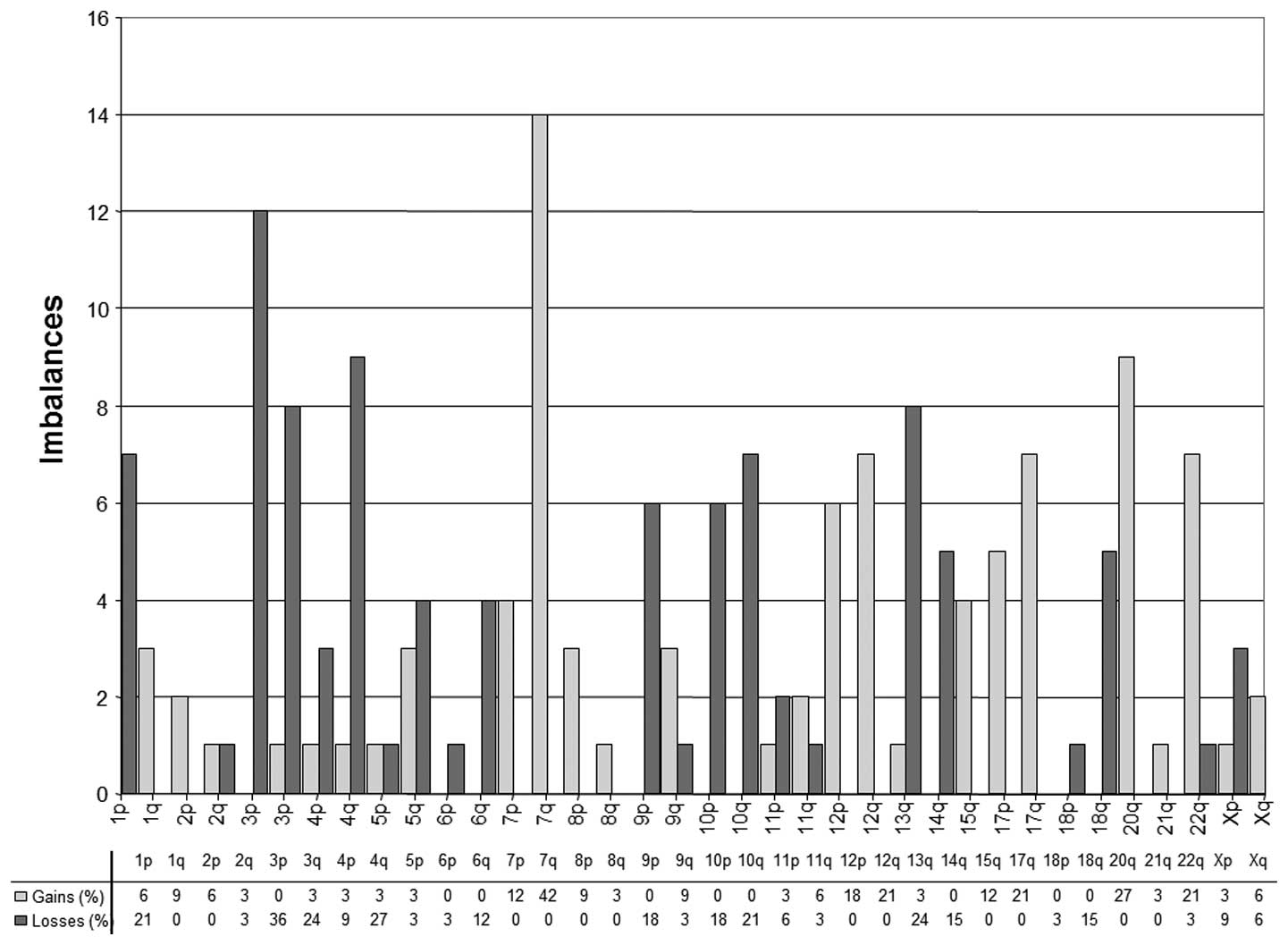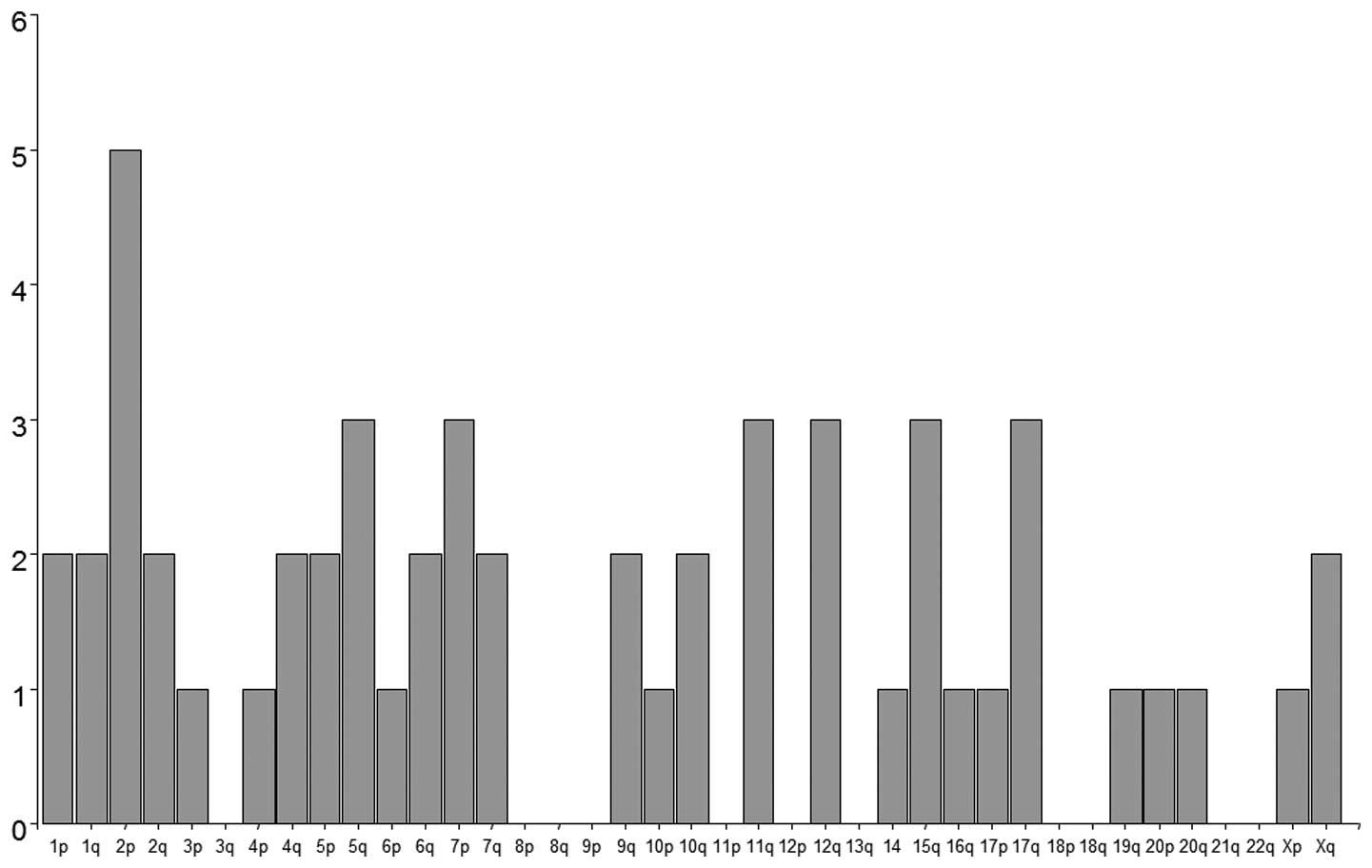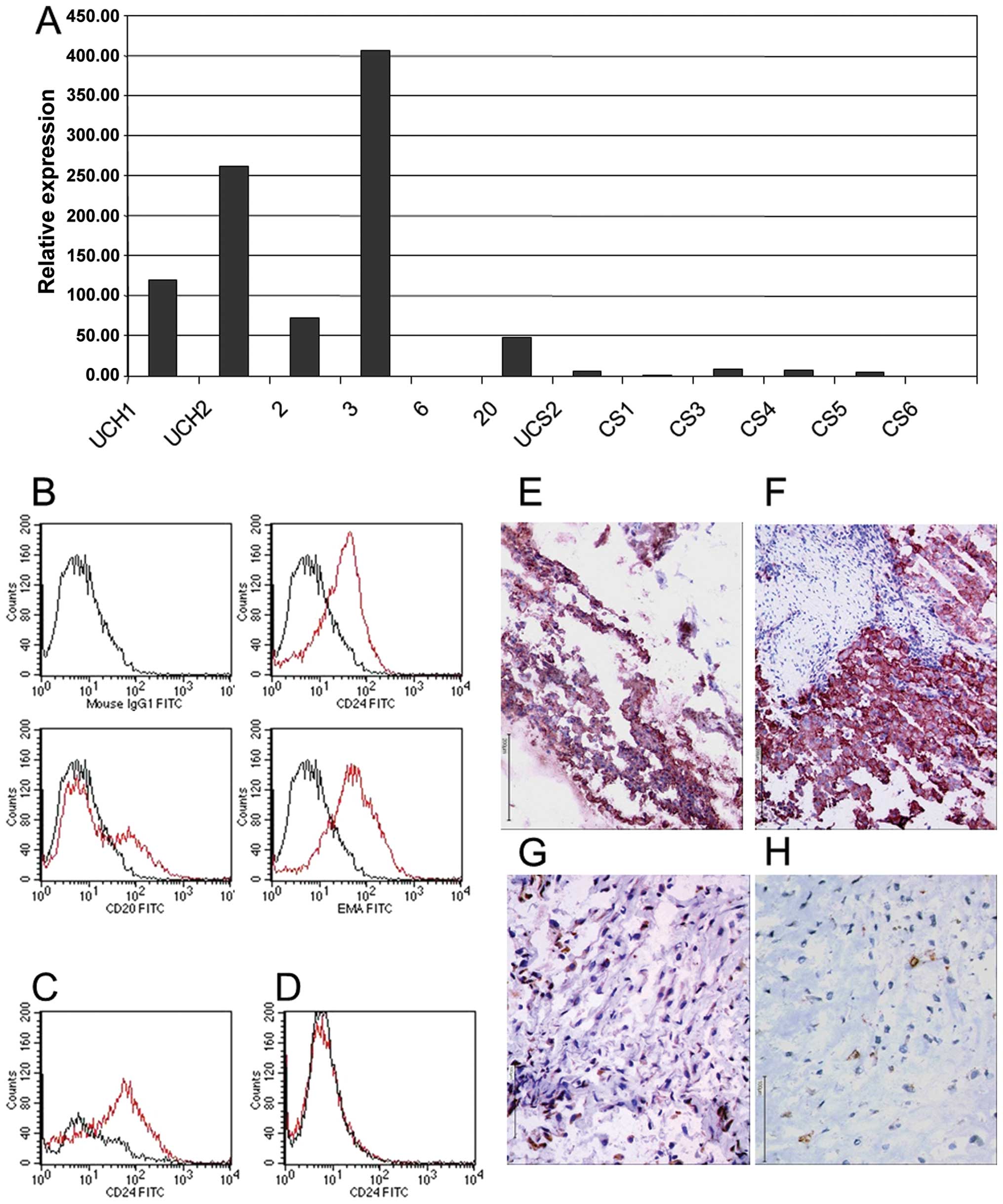|
1.
|
Dorfman HD and Czerniak B: Bone tumors.
Mosby; St. Louis, MO: 1998
|
|
2.
|
Mirra JM, Nelson SD, Della Rocca C and
Mertens F: Chordoma. Pathology and Genetics of Tumors of Soft
Tissue and Bone World Health Organization Classification of Tumors.
Fletcher CDM, Unni KK and Mertens F: IARC Press; Lyon: pp. 316–317.
2002
|
|
3.
|
Dewaele B, Maggiani F, Floris G, Ampe M,
Vanspauwen V, Wozniak A, Debiec-Rychter M and Sciot R: Frequent
activation of EGFR in advanced chordomas. Clin Sarcoma Res.
25:42011. View Article : Google Scholar : PubMed/NCBI
|
|
4.
|
Diaz RJ, Guduk M, Romagnuolo R, Smith CA,
Northcott P, Shih D, Berisha F, Flanagan A, Munoz DG, Cusimano MD,
Pamir MN and Rutka JT: High-resolution whole-genome analysis of
skull base chordomas implicates FHIT loss in chordoma pathogenesis.
Neoplasia. 14:788–798. 2012.PubMed/NCBI
|
|
5.
|
Shalaby AA, Presneau N, Idowu BD, Thompson
L, Briggs TR, Tirabosco R, Diss TC and Flanagan AM: Analysis of the
fibroblastic growth factor receptor-RAS/RAF/MEK/ERK-ETS2/ brachyury
signalling pathway in chordomas. Mod Pathol. 22:996–1005. 2009.
View Article : Google Scholar : PubMed/NCBI
|
|
6.
|
Stacchiotti S, Tamborini E, Lo Vullo S,
Bozzi F, Messina A, Morosi C, Casale A, Crippa F, Conca E, Negri T,
Palassini E, Marrari A, Palmerini E, Mariani L, Gronchi A, Pilotti
S and Casali PG: Phase II study on lapatinib in advanced
EGFR-positive chordoma. Ann Oncol. 24:1931–1936. 2013. View Article : Google Scholar : PubMed/NCBI
|
|
7.
|
Scheil S, Bruederlein S, Liehr T, Starke
H, Herms J, Schulte M and Moeller P: Genome wide analysis of 16
chordomas by comparative genomic hybridization and cytogenetics of
the first human chordoma cell line, U-CH1. Genes Chromosomes
Cancer. 32:203–211. 2001. View
Article : Google Scholar : PubMed/NCBI
|
|
8.
|
Larizza L, Mortini P and Riva P: Update on
the cytogenetics and molecular genetics of chordoma. Hered Cancer
Clin Pract. 3:29–41. 2005. View Article : Google Scholar : PubMed/NCBI
|
|
9.
|
Kelley MJ, Korczak JF, Sheridan E, Yang X,
Goldstein AM and Parry DM: Familial chordoma, a tumor of
notochordal remnants, is linked to chromosome 7q33. Am J Hum Genet.
69:454–460. 2001. View
Article : Google Scholar : PubMed/NCBI
|
|
10.
|
Szuhai K and Hogendoorn PC: ‘The chicken
or the egg?’ dilemma strikes back for the controlling mechanism in
chordoma. J Pathol. 228:261–265. 2012.
|
|
11.
|
Presneau N, Shalaby A, Ye H, Pillay N,
Halai D, Idowu B, Tirabosco R, Whitwell D, Jacques TS, Kindblom LG,
Brüderlein S, Möller P, Leithner A, Liegl B, Amary FM, Athanasou
NN, Hogendoorn PC, Mertens F, Szuhai K and Flanagan AM: Role of the
transcription factor T (brachyury) in the pathogenesis of sporadic
chordoma: a genetic and functional-based study. J Pathol.
223:327–335. 2011. View Article : Google Scholar : PubMed/NCBI
|
|
12.
|
Bruederlein S, Sommer JB, Meltzer PS, Li
S, Osada T, Ng D, Möller P, Alcorta DA and Kelley MJ: Molecular
characterization of putative chordoma cell lines. Sarcoma.
2010:6301292010.PubMed/NCBI
|
|
13.
|
Fisher LW, Hawkins GR, Tuross N and
Termine JD: Purification and partial characterization of small
proteoglycans I and II, bone sialoproteins I and II, and
osteonectin from the mineral compartment of developing human bone.
J Biol Chem. 262:9702–9708. 1987.PubMed/NCBI
|
|
14.
|
Straeter J, Walczak H, Pukrop T, von
Müller L, Hasel C, Kornmann M, Mertens T and Möller P: TRAIL and is
receptors in the colonic epithelium: a putative role in the defense
of viral infections. Gastroenterology. 122:659–666. 2002.
View Article : Google Scholar : PubMed/NCBI
|
|
15.
|
Gisselsson D, Pålsson E, Höglund M,
Domanski H, Mertens F, Pandis N, Sciot R, Dal Cin P, Bridge JA and
Mandahl N: Differentially amplified chromosome 12 sequences in low-
and high-grade osteosarcoma. Genes Chromosomes Cancer. 33:133–140.
2002. View
Article : Google Scholar : PubMed/NCBI
|
|
16.
|
Van Gelder RN, von Zastrow ME, Yool A,
Dement WC, Barchas JD and Eberwine JH: Amplified RNA synthesized
from limited quantities of heterogeneous cDNA. Proc Natl Acad Sci
USA. 87:1663–1667. 1990.PubMed/NCBI
|
|
17.
|
Kappler R, Hess I, Schlegel J and Hahn H:
Transcriptional up-regulation of Gadd45a in Patched-associated
medulloblastoma. Int J Oncol. 25:113–120. 2004.PubMed/NCBI
|
|
18.
|
Ruiz I, Altaba A, Sánchez P and Dahmane N:
Gli and hedgehog in cancer: tumours, embryos and stem cells. Nat
Rev Cancer. 2:361–372. 2002. View
Article : Google Scholar : PubMed/NCBI
|
|
19.
|
Kappler R, Calzada-Wack J, Schnitzbauer U,
Koleva M, Herwig A, Piontek G, Graedler F, Adamski J, Heinzmann U,
Schlegel J, Hemmerlein B, Quintanilla-Martinez L and Hahn H:
Molecular characterization of Patched-associated rhabdomyosarcoma.
J Pathol. 200:348–356. 2003. View Article : Google Scholar : PubMed/NCBI
|
|
20.
|
Hallor KH, Staaf J, Jönsson G, Heidenblad
M, Vult von Steyern F, Bauer HC, Ijszenga M, Hogendoorn PC, Mandahl
N, Szuhai K and Mertens F: Frequent deletion of the CDKN2A locus in
chordoma: analysis of chromosomal imbalances using array
comparative genomic hybridisation. Br J Cancer. 98:434–442. 2008.
View Article : Google Scholar
|
|
21.
|
Le LP, Nielsen GP, Rosenberg AE, Thomas D,
Batten JM, Deshpande V, Schwab J, Duan Z, Xavier RJ, Hornicek FJ
and Iafrate AJ: Recurrent chromosomal copy number alterations in
sporadic chordomas. PLoS One. 6:e188462011. View Article : Google Scholar : PubMed/NCBI
|
|
22.
|
Rittling SR and Chambers AF: Role of
ostopontin in tumour progression. Br J Cancer. 17:1877–1881. 2004.
View Article : Google Scholar : PubMed/NCBI
|
|
23.
|
Otto WR and Rao J: Tomorrow’s skeleton
staff: mesenchymal stem cells and the repair of bone and cartilage.
Cell Prolif. 37:97–110. 2004.
|
|
24.
|
Edwards YH, Putt W, Lekoape KM, Stott D,
Fox M, Hopkinson DA and Sowden J: The human homolog T of the mouse
T (Brachyury) gene; gene structure, cDNA sequence, and assignment
to chromosome 6q27. Genome Res. 6:226–233. 1996. View Article : Google Scholar : PubMed/NCBI
|
|
25.
|
Hsu W, Mohyeldin A, Shah SR, Ap Rhys CM,
Johnson LF, Sedora-Roman NI, Kosztowski TA, Awad OA, McCarthy EF,
Loeb DM, Wolinsky JP, Gokaslan ZL and Quiñones-Hinojosa A:
Generation of chordoma cell line JHC7 and the identification of
Brachyury as a novel molecular target. J Neurosurg. 115:760–769.
2011. View Article : Google Scholar : PubMed/NCBI
|
|
26.
|
Yang XR, Ng D, Alcorta DA, Liebsch NJ,
Sheridan E, Li S, Goldstein AM, Parry DM and Kelley MJ: T
(brachyury) gene duplication confers major susceptibility to
familial chordoma. Nat Genet. 41:1176–1178. 2009. View Article : Google Scholar : PubMed/NCBI
|
|
27.
|
Nelson AC, Pillay N, Henderson S, Presneau
N, Tirabosco R, Halai D, Berisha F, Flicek P, Stemple DL, Stern CD,
Wardle FC and Flanagan AM: An integrated functional genomics
approach identifies the regulatory network directed by brachyury
(T) in chordoma. J Pathol. 228:274–285. 2012. View Article : Google Scholar : PubMed/NCBI
|
|
28.
|
Launay SG, Chetaille B, Medina F, Perrot
D, Nazarian S, Guiramand J, Moureau-Zabotto L and Bertucci F:
Efficacy of epidermal growth factor receptor targeting in advanced
chordoma: case report and literature review. BMC Cancer.
11:4232011. View Article : Google Scholar : PubMed/NCBI
|
|
29.
|
Kristiansen G, Winzer KJ, Mayordomo E,
Bellach J, Schluns K, Denkert C, Dahl E, Pilarsky C, Altevogt P,
Guski H and Dietel M: CD24 expression is a new prognostic marker in
breast cancer. Clin Cancer Res. 9:4909–4913. 2004.
|
|
30.
|
Kristiansen G, Pilarsky C, Pervan J,
Sturzebecher B, Stephan C, Jung K, Loening S, Rosenthal A and
Dietel M: CD24 expression is a significant predictor of PSA relapse
and poor prognosis in low grade or organ confined prostate cancer.
Prostate. 58:183–192. 2004. View Article : Google Scholar : PubMed/NCBI
|
|
31.
|
Sabatier R, Finetti P, Adelaide J, Guille
A, Borg JP, Chaffanet M, Lane J, Birnbaum D and Bertucci F:
Down-regulation of ECRG4, a candidate tumor suppressor gene, in
human breast cancer. PLoS One. 6:e276562011. View Article : Google Scholar : PubMed/NCBI
|
|
32.
|
Su T, Liu H and Lu S: Cloning and
identification of cDNA fragments related to human esophageal
cancer. China J Oncol. 20:254–257. 1998.(In Chinese).
|
|
33.
|
Mirabeau O, Perlas E, Severini C, Audero
E, Gascuel O, Possenti R, Birney E, Rosenthal N and Gross C:
Identification of novel peptide hormones in the human proteome by
hidden Markov model screening. Genome Res. 17:320–327. 2007.
View Article : Google Scholar : PubMed/NCBI
|
|
34.
|
Chen C, Yang HL, Chen KW, Wang GL, Lu J,
Yuan Q, Gu YP and Luo ZP: High expression of survivin in sacral
chordoma. Med Oncol. 30:5292013. View Article : Google Scholar : PubMed/NCBI
|














